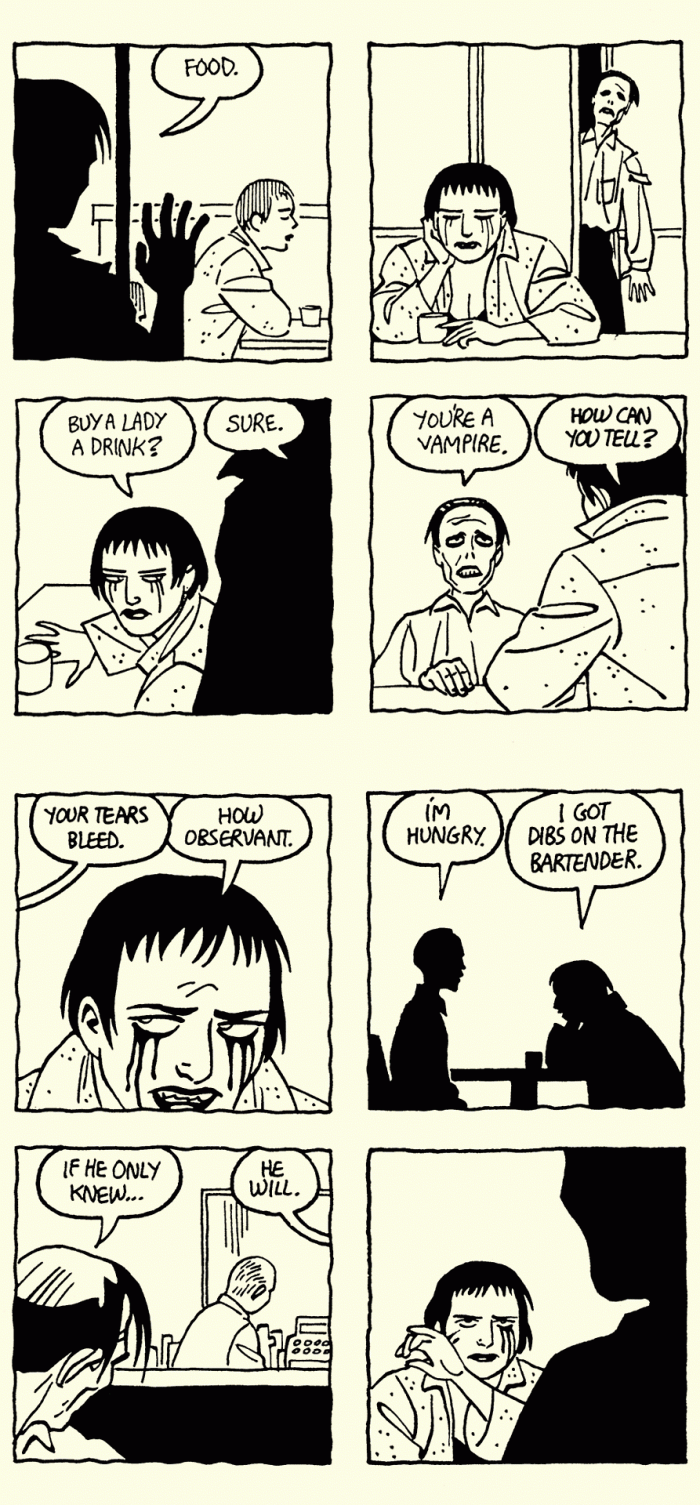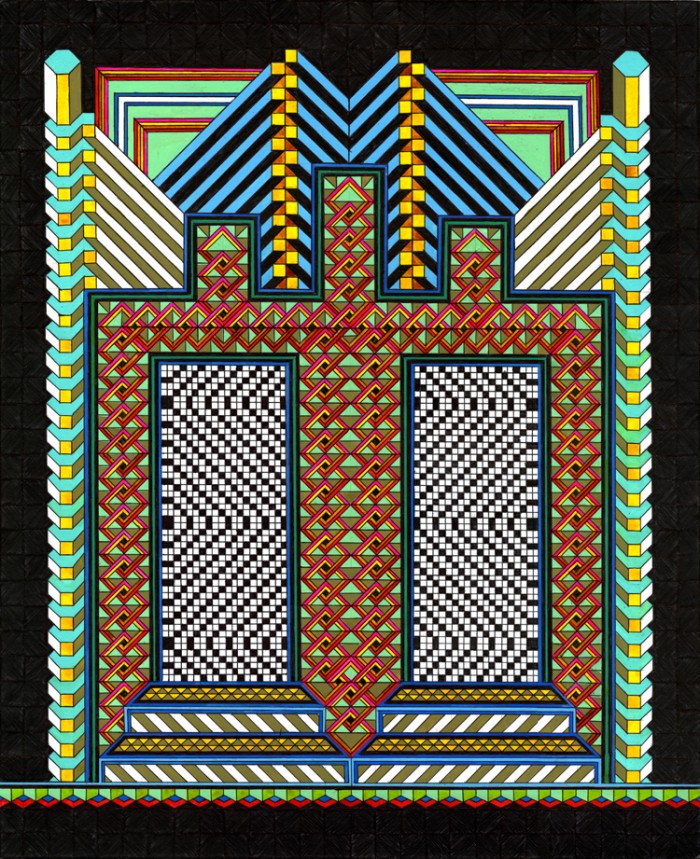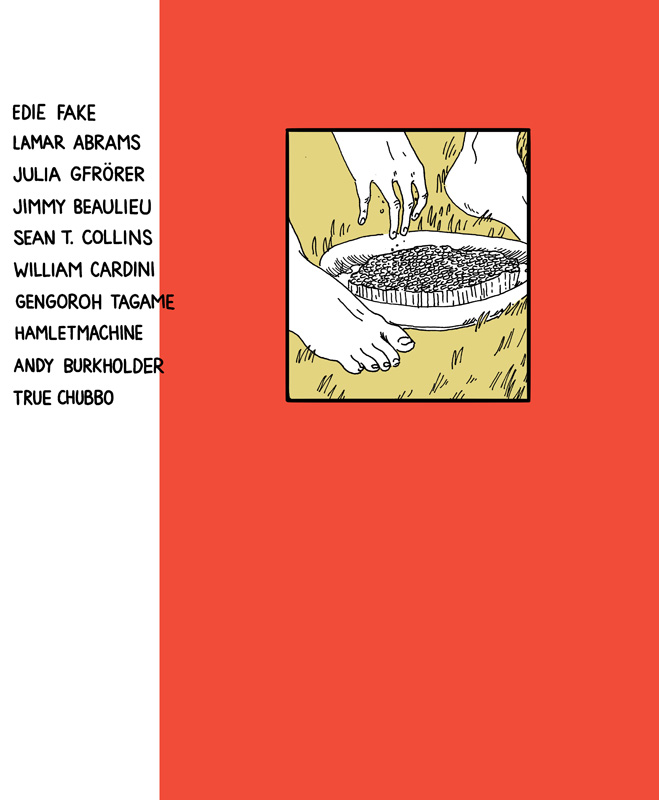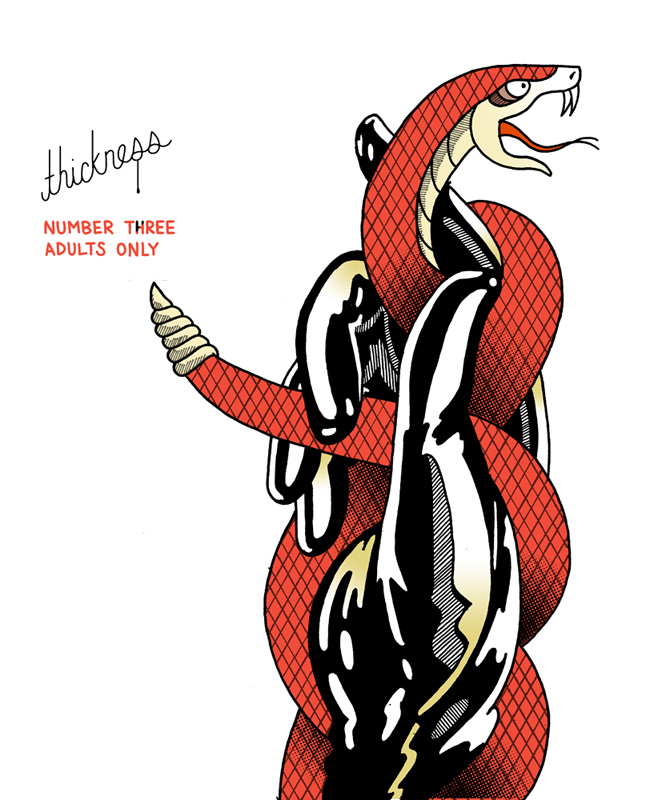Posts Tagged ‘Edie Fake’
Friday night with Vorpalizer
June 7, 2013Over the past couple of weeks I’ve written about Memory Palaces by Edie Fake, “The Sea-Bell, or Frodo’s Dreme” by J.R.R. Tolkien, “The Ghoul Man” by Jaime Hernandez, and “The Cask of Amontillado” by Edgar Allan Poe for Vorpalizer. Check them out.
Thickness #3: Back cover, bed of contents
June 6, 2012THICKNESS #3
30XX by Lamar Abrams
PROTESTPLOITATION by Jimmy Beaulieu
NIGHTCRAWLERS by Edie Fake
THE CHASM by Julia Gfrörer
THE COCKROACH by William Cardini & Sean T. Collins
STANDING OVATIONS by Gengoroh Tagame
QVIET by Andy Burkholder
…and a pinup by HamletMachine
(via Ryan Sands)
Love Me Like a Reptile/Feel My Serpentine
June 1, 2012Behold Edie Fake’s cover for Thickness #3, the erotic comics anthology featuring Edie Fake, Lamar Abrams, Julia Gfrörer, Jimmy Beaulieau, Sean T. Collins (yep, me!), William Cardini (who drew the thing I wrote), Gengoroh Tagame, Hamletmachine, Andy Burkholder, and True Chubbo, edited by Ryan Sands and Michael DeForge. Debuts at CAKE on June 16, available online everywhere shortly thereafter.
Comics Time: Gaylord Phoenix
May 23, 2011 Gaylord Phoenix
Gaylord Phoenix
Edie Fake, writer/artist
Secret Acres, 2010
256 pages
$17.95
Buy it from Secret Acres
Buy it from Amazon.com
Well now, here’s a pleasure: a book that gets steadily better as it goes on, so much so that by the time you finish it it’s as though you’re reading a second, later, better book by the same author. In some sense that’s literally true: Cartoonist Edie Fake serialized the story in the minicomic series of the same name over the course of years, so you’re seeing the work of an older, more experienced artist by book’s end. But his artistic growth isn’t just a “well hey, good for him” situation, it’s a happy complement to the growth of the wandering, questing title character. Watching Fake’s art tighten up — his placement of the characters on the page become more self-assured, his pacing become more controlled, his blank white pages fill up with elaborate psychedelic vistas and bold dot or grid textures and lovely two-tone color — does as much to show us his hero’s maturation as anything the character himself does or says or sees.
Like Kolbeinn Karlsson’s The Troll King, Gaylord Phoenix talks about homosexuality using the narrative language of myths and monsters with a pronounced art-comics accent. We first meet the Gaylord Phoenix (who’s a dome-headed, tube-nosed naked dude and not a phoenix at all) as he is about to be attacked by a crystalline monster; he survives the attack, but the wound he sustains carries within it an infection of aggression that eventually drives him to kill his lover. When the slain man is revived at the behest of a subterranean crocodile emperor, the phoenix returns to claim him, but the lover uses the magic now present inside him to cast the phoenix away. What follows is a journey consisting of encounters with various creatures and beings seeking to use the phoenix for their own ends, leading to sex, violence, enlightenment, and sometimes all three.
Fake is a lateral thinker when it comes to devising ways to depict all these things: The result, whether it’s a crocodile tail inserted through the anus and protruding out the mouth, penises that look like giant macaroni and thus can both penetrate and be penetrated, or a multiplicity of cocks that cover a crotch like the tentacles of a sea anemone, is racy, unexpected, a bit weird, and sometimes even a bit scary, which is pretty much how sex ought to be. But aggression is just as central to the story, a fact that’s unfortunate for the characters but a breath of fresh air in how it reclaims the province of traditional masculinity for homosexuality even while preserving queerness’ outsider identity. The climax (no pun intended) further emphasizes the importance of this synthesis, as the Gaylord Phoenix discovers that everyone he’s met on his journey is now literally a part of him, unleashed in what can only be described as the world’s first solo orgy. “It is all with me now,” he proclaims. “At last I hold my own…and partake of who I am.”
The problem with the book, I suppose, is right there: It’s a bit too neatly allegorical to ever truly soar, and its didactic conclusion left me feeling a little too much like I’d just heard the phrase “And the moral of the story is….” I wish the narrative had the crazy courage of the image-making — Fake’s beautiful block-print lettering, say, or the dark navy-blue-colored series of double splashes that conclude the book, or the way he can fill a page with tiny accumulated circles and waves that buffet and subsume, or the lovely tangerine halftone and clean rounded lines that comprise the phoenix’s final mystical encounter. But the key here all along has been to let the artistic growth on display speak for itself, to do the heavy lifting of the story itself. Actions speak louder than words.
Comics Time: Monster
January 21, 2011 Monster
Monster
Paul Lyons, Jim Drain, Michael DeForge, Michaela Zacchilli, Brian Ralph, Chuck Forsman, James Kochalka, Jim Rugg, Peter Edwards, Andy Estep, Oscar Estep, CF, Brian Chippendale, Blade, Keith McCulloch, Mike Taylor, Roby Newton, Edie Fake, Leif Goldberg, Keith Jones, Dennis Franklin, Jo Dery, Erik Talley, Beatrice McGeoch, Tony Astone, Mat Brinkman, Nick Thorburn, Melissa Mendes, Aaron DeMuth, writers/artists
Paul Lyons, editor
self-published (I think), October 2010
88 pages
$20
Buy it from PictureBox
They’re gettin’ the band back together, man! From out of the rubble of Fort Thunder rises the surprise 2010 revival of the gigantically influential Providence underground-art institution’s house anthology, featuring mostly-about-monsters work from all six of the Fort’s core cartoonists — Brinkman, Chippendale, Ralph, Drain, Lyons, Goldberg. Plus Andy Estep, Peter Edwards, Roby Newton, and a lot of other people you’ll see listed as having lived/worked/played in the Fort. Plus fellow-travelers like Providence’s CF and Jo Derry and Highwater’s James Kochalka. Plus Jim Rugg and Michael DeForge and Chuck Forsman and other leading lights of post-Fort alternative comics. And a reunion tour is exactly what it feels like.
Don’t get me wrong, there’s fine comics in this beautifully printed navy-blue-and-white package, many of which take advantage of its unusually large trim size. (We’re not talking Kramers Ergot 7 territory, but the thing is big. Think the Wednesday Comics hardcover.) Brian Ralph uses his comparatively clean cartoony style for a hilariously violent giant-robot comic, “Voltron from Hell,” basically, with huge panels and splash pages taking perversely pretty delight in mass destruction and death. The final panel of CF’s weird tale about an ambulance driver-cum-cat burglar who sneaks into the house of a woman with a mysterious disease actually made me jump — just a beautifully done little scare. Brian Chippendale’s story ties in with his Puke Force webcomic and gives him a chance to draw some villains at full splash-page size. I thought Chuck Forsman cut himself off at the knees a bit with his punchline ending, but until then his contribution was a creepy little thing that reminded me favorably of the urban legend my Delawarean wife recounted to me about the zoobies, the inbred mutant children of the DuPont family who would roam around the woods waylaying passers-by. There are insanely METAL full-page illustrations from Brinkman (who’s by now made a wonderful career of such things), Tony Astone, and Dennis Franklin — I mean, I laughed out loud at how fuckin’ devil-horns they were. And Lyons’s wraparound cover portraits of various barfing beasts is breathtaking, one of the most impressive single comics images of the year.
But in a way, the Fort Thunder aesthetic is a victim of its own success. I lost track of the number of good-to-great comics that came out this year bearing its influence, and those apples-to-apples comparisons make it hard for the work here, which I think all parties involved would admit was done more for fun than for tear-down-the-walls boundary-pushing, to stand out. In terms of anthologies alone, you could stand this one right between Studygroup 12, Closed Caption Comics, Smoke Signals, Diamond Comics, and Mould Map. Fort Thunder and the Providence scene’s DNA is now deeply embedded in an array publishers, including not just the late and lamented Highwater, Bodega, and Buenaventura, but also PictureBox, Secret Acres, Koyama, Nobrow, Pigeon, Gaze, and even the mighty Drawn & Quarterly. Moreover, whether you call it fusion or New Action or simply slap an alt- prefix in front of horror or SF or fantasy, Fort Thunder’s pioneering jailbreak of genre from the mainstream American comics prison has subsequently allowed it to become almost inescapable in smart-comics circles. Finally, Chippendale, Brinkman, Forsman, DeForge, CF, Fake, and Rugg are all in direct competition with work they put out elsewhere last year, most of which was more ambitious. And understandably so! Seriously, I’m not complaining — Monster is what I think it set out to be. It’s seeing Floyd get together for an awesome Live 8 gig, rather than seeing Waters and Gilmour working together again, and as such it’s more a treat for the fans than documentary evidence of why we became fans in the first place.





